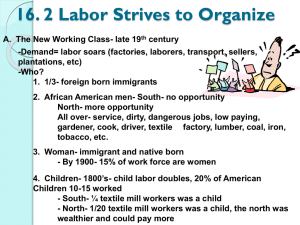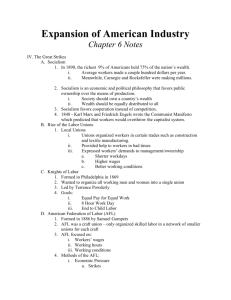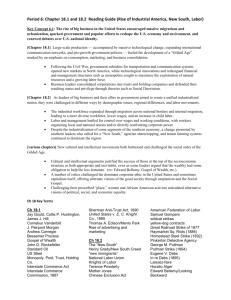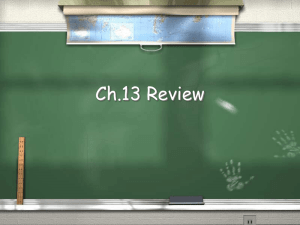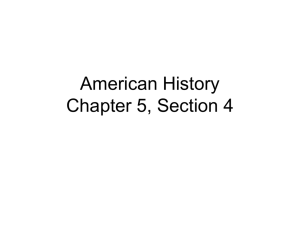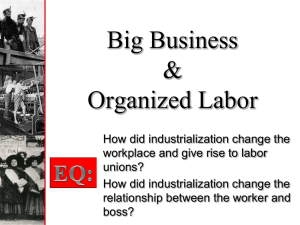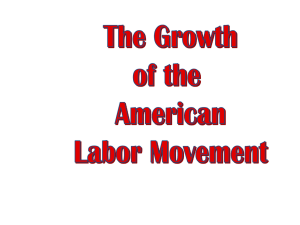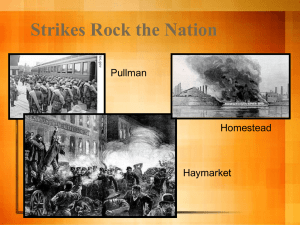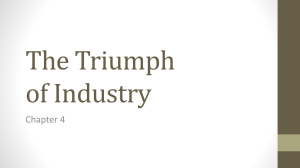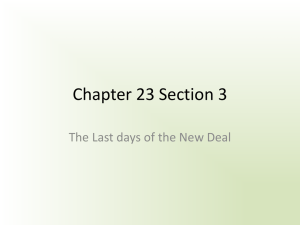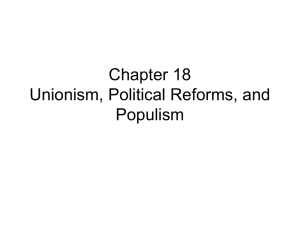Labor unions in the gilded age
advertisement
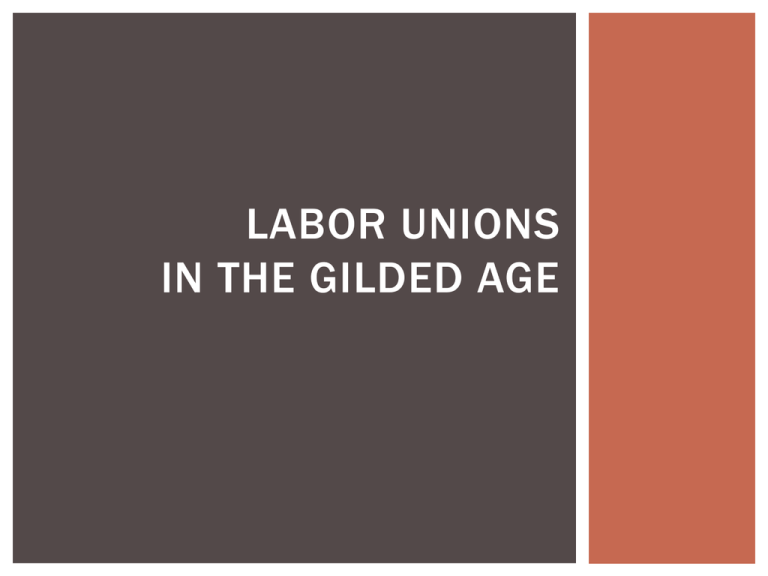
LABOR UNIONS IN THE GILDED AGE OVERVIEW What’s a union? Why unions? The rise of unions Major unions Major events Women in the labor movement WHAT’S A UNION? WHAT’S A UNION? Groups of workers in the same industry Elect leaders to negotiate with employers Engage in collective bargaining over wages, benefits, and working conditions Sometimes launch strikes to enhance bargaining power STRIKES Strike: when a group of workers refuses to work in the hopes of getting better pay, benefits, or working conditions WHY UNIONS?: WORKING CONDITIONS IN THE INDUSTRIAL ERA INDUSTRIALIZATION More people start working for wages Work becomes much more unpleasant for many Low-wage, low-skill jobs makes workers easier to replace less bargaining power WORKING CONDITIONS Long hours Low pay Most family members had to work Extremely difficult manual labor, often with no rest Dangerous work 1880-1900: 35,000 deaths/year in factory/mine accidents 500,000 - 1 million more injuries Panic of 1873 leads employers to lay off workers and cut wages RETALIATION Strikebreakers (“scabs”): workers hired by companies to replace striking workers Immigrants African Americans Intimidation/firing Sabotage/infiltration Pinkerton guards Pinkerton National Detective Agency: founded 1850 in Chicago Private security and law enforcement firm Frequently hired by factory owners to intimidate union activists and protect strikebreakers Reputation for violence THE RAILROAD STRIKES OF 1877 Many small, local, trade -specific unions and guilds July 1877: railroad unions organize strikes to protest wage cuts Violent confrontations between strikers and police huge impact on rail travel and shipping Worst violence in Pittsburgh July 21: State troops fire on demonstrators, killing 10 Mob sets railway property on fire, burning 2,000 train cars Troops shoot their way out, killing 20 more Rutherford Hayes sends federal soldiers Strikes collapse thanks to imbalance of force, weak economy (more strikebreakers), and lack of central leadership Spurs workers to organize across trades UNION MEMBERSHIP, 1900-2000 THE RISE OF UNIONS THE KNIGHTS OF LABOR Founded 1869 Terence V. Powderly Included skilled + unskilled, women, immigrants, black workers Ultimate goal: workers’ cooperatives Generally opposed to strikes, but engaged in some militant action THE HAYMARKET AFFAIR May 1, 1886: general strike for an 8 -hour day led by all unions in Chicago 3 days of peaceful demonstrations; police shoot and kill two union members while breaking up a fight on May 3 May 4: rally to protest police violence in Haymarket Square Police approach to break up the orderly rally Someone in the crowd throws a bomb 7 killed, 67 injured Mass arrests of anarchists and union activists Result: public becomes suspicious of labor unions; destroys the Knights of Labor THE AMERICAN FEDERATION OF LABOR Founded 1886 Samuel Gompers Generally moderate Concrete goals: wages, hours, collective bargaining Generally excluded unskilled workers, immigrants, women, and African Americans THE HOMESTEAD STRIKE June 1892: Amalgamated Association of Iron and Steelworkers (AA) negotiating with Carnegie steel plant in Homestead, PA Henry Frick closes plant and hires Pinkertons to protect strikebreakers July 5: Firefight between workers and Pinkertons State militia called in to break the strike and protect new, non-union employees July 23: Anarchist attempts to assassinate Frick Impact: setback for AFL; loss for strikers THE PULLMAN STRIKE: CAUSES Pullman, Chicago: a “company town” for workers building Pullman railway cars 1894: Pullman lays off workers and cuts pay, but does not lower rents Eugene V. Debs travels to Pullman and recruits factory workers to the American Railway Union (ARU) The ARU calls for a boycott of all trains carrying Pullman cars THE PULLMAN STRIKE: BOYCOTT June 26, 1894: ARU members begin refusing to work on trains carrying Pullman cars 125,000 workers walked off the job within the next four days Huge disruption to transportation, shipping, and the economy in much of the country Rail traffic shut down in 27 states Railroads hire strikebreakers (“scabs”), including black workers Violence by some union supporters angers the public and increases calls for federal intervention THE PULLMAN STRIKE: INTERVENTION President Cleveland directs the government to shut down the strike Federal troops protect strikebreakers and force an end to the boycott 30 strikers killed, 57 wounded $800 million in property damage By August 2, ARU ends the boycott; most strikers abandon the union and return to work INTERNATIONAL WORKERS OF THE WORLD Founded 1905 by radical Colorado miners Known as IWW or “the Wobblies” “One big union”: all laborers, regardless of race or trade Ultimate goal: socialism Often supported violence and sabotage Collapsed during WWI and Red Scare WOMEN IN THE LABOR MOVEMENT Most unions excluded women from membership; nearly all excluded them from leadership A few exceptions: International Ladies Garment Workers Union; Lawrence textile mills 1919: IBEW Telephone Operator’s Department strikes, shutting down phone service in five states Women’s Trade Union League (W TUL) – founded 1903; link between women’s and labor movements MARY HARRIS “MOTHER” JONES Lived approx. 1837-1930 Traveled the country organizing coal miners and other laborers Unconventional tactics Included black and white workers Used women and children in her protests Didn’t wear a bow tie, but…
